The kurinji or Strobilanthes kunthiana is a fascinating flowering plant that has captivated people for centuries with its rare, gregarious blooming habits. Native to the Western Ghats mountain range in India, this colorful plant puts on an unforgettable display when entire hillsides erupt into purple-blue flowers all at once every 12 years.
If you want to grow the mystical Strobilanthes kunthiana in your own garden, following some key tips will help you succeed. With the right growing conditions and care, you can nurture this fussy plant to thrive.
Ideal Growing Conditions for Strobilanthes kunthiana
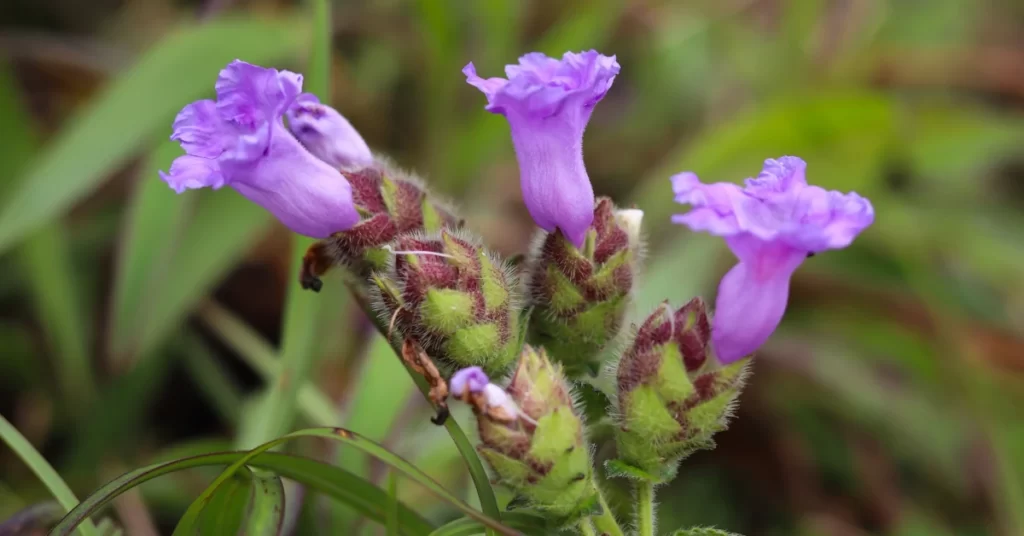
To grow healthy kurinji plants with lush foliage and the chance to flower, simulate the environment of their native mountain habitat as closely as possible. This flowering shrub thrives in the following conditions:
- Soil – Loose, humus-rich, well-draining soil with a loamy texture and pH between 6.1-7.8
- Sun – Dappled sunlight or light shade
- Water – Even moisture, not allowing soil to completely dry out or become waterlogged
- Temperature – Cool weather, ideally 40-75°F
- Humidity – Consistently high humidity of 60-80%
- Hardiness Zone – Zone 10 or warmer
Mimicking the climate where Strobilanthes naturally grow will provide the best results. Cool mountain air, evenly moist soil, filtered sunlight, and no extremes in temperature or aridity are key.
Check Out How to Care Pink Princess Philodendron here
The Best Soil for Growing Strobilanthes kunthiana
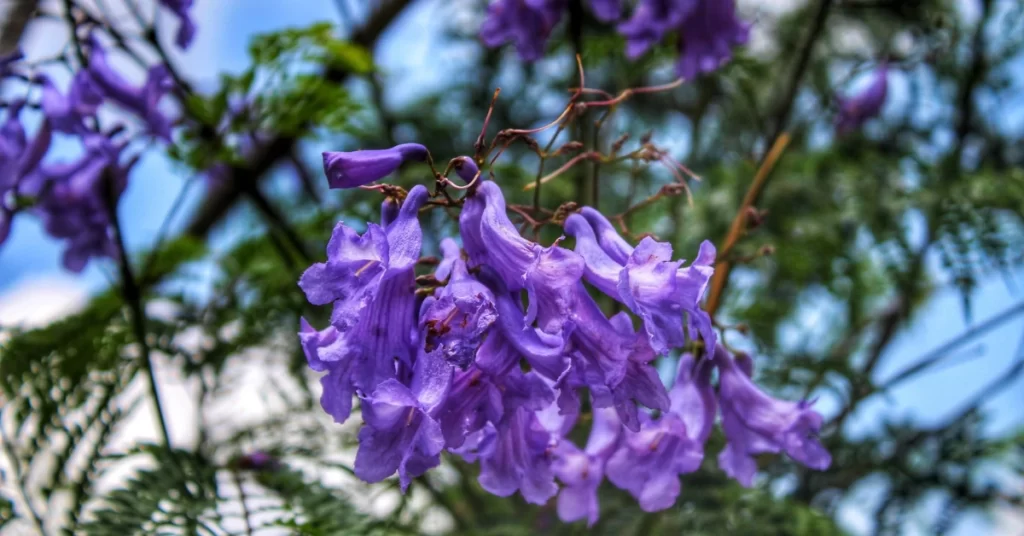
Kurinji plants need soil that drains well but also retains some moisture. The ideal potting mix to use is:
- 1 part loam
- 1 part peat moss
- 1 part compost
- 1 part coarse sand
This blend creates loose, humus-rich soil with excellent drainage. The acidic peat balances out the other ingredients to reach the ideal pH range for Strobilanthes between 6.1-7.8.
You can also amend existing garden soil by mixing in compost and sand to achieve better texture and drainage for growing Strobilanthes kunthiana. Just be sure no water accumulates in the root zone.
Sunlight Requirements for Kurinji
In their native habitat, Strobilanthes kunthiana grow beneath the canopy of shola forests. This provides dappled sunlight and bright shade.
Aim to replicate these filtered light conditions when growing kurinji. A spot with 2-6 hours of gentle sunlight filtering through trees or partially shaded by buildings is perfect.
If planting in full sun, provide shade cloths to block out excess intensity. Too much harsh light can scorch leaves. But insufficient sunlight will inhibit flowering.
Watering Needs for Strobilanthes kunthiana
The keys to watering are consistent moisture without saturation. Kurinji roots demand evenly damp soil at all times but also require good drainage.
During spring and summer when actively growing, water whenever the top several inches become dry. Pour water slowly at soil level rather than overhead. This allows it to fully saturate the root zone without runoff.
In fall and winter during dormancy, reduce watering frequency but don’t allow pots to completely dry out. The root ball should remain lightly moist for healthy overwintering.
Well-draining soil and pots with holes prevent excessive moisture. Avoid waterlogged or muddy soil, which leads to root rot in Strobilanthes.
Check Out How to Grow Gmelina Arborea? here
How to Propagate Strobilanthes kunthiana
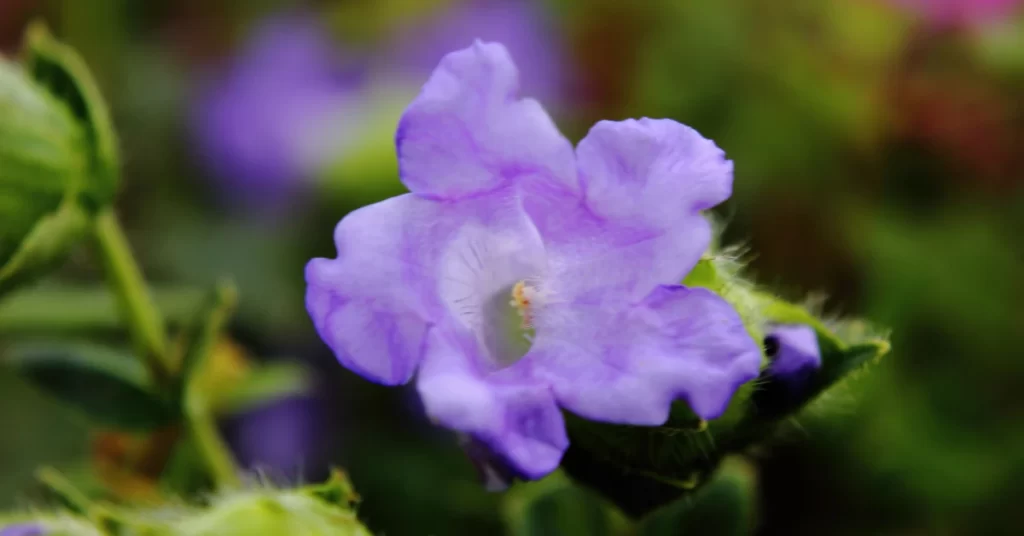
Kurinji can be propagated by seed or semi-hardwood cuttings. Starting new plants from an existing specimen allows you to expand your collection for free.
Propagating from Seeds
Collect fresh seeds during fall once seed capsules split open. Sow thinly in flats or pots using well-draining starting mix. Cover seeds lightly with 1⁄4 inch layer of mix; don’t bury too deeply. Maintain 70°F soil temperature with bottom heat. Germination takes 14 to 21 days.
Transplant seedlings when 3-4 true leaves emerge. Harden off gradually before moving outside.
Propagating from Cuttings
In spring or summer, take 5-6 inch tip cuttings from new growth. Remove lower leaves and dip basal end in rooting hormone. Insert into moist seedling mix leaving only top leaves exposed.
Enclose cutting containers in clear humidity domes to boost air moisture around leaves. Keep soil consistently damp but not flooded until new roots establish in 6-8 weeks. Harden off before transplanting outside into garden beds or larger pots.
Read More About How to Grow Jai Jui Flower here
When and How to Transplant Kurinji
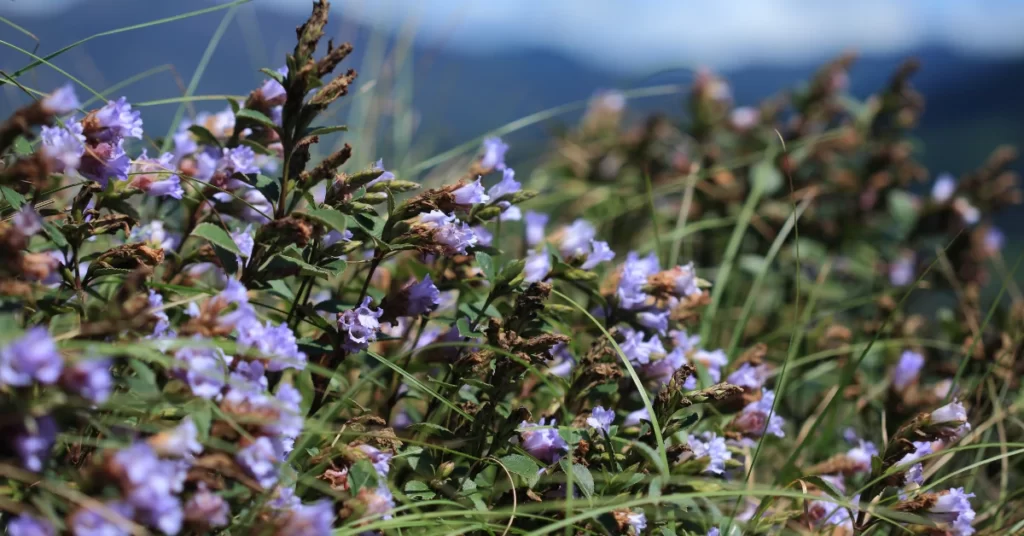
For the best transplant success with minimal shock, choose young Strobilanthes kunthiana plants in vigorous health showing fresh foliage growth. Transplant them in the following windows:
- Spring – Late March to early May as temperatures warm
- Summer – Mid June to late August during rainy season
- Fall – September to early November before pre-dormancy dieback
Avoid transplanting when daytime highs exceed 80°F because extreme heat stresses roots. Also skip winter dormancy from December through February when plants are vulnerable.
Carefully dig up and transfer kurinji immediately into prepared garden beds amended with extra compost. Or re-pot into containers just one size bigger without disturbing root balls. Keep freshly transplanted plants shaded and well-watered initially. New root growth establishes within 2-4 weeks.
Read More About How to Grow Commelina Benghalensi here
Caring for Strobilanthes kunthiana: Pruning, Pests & Problems
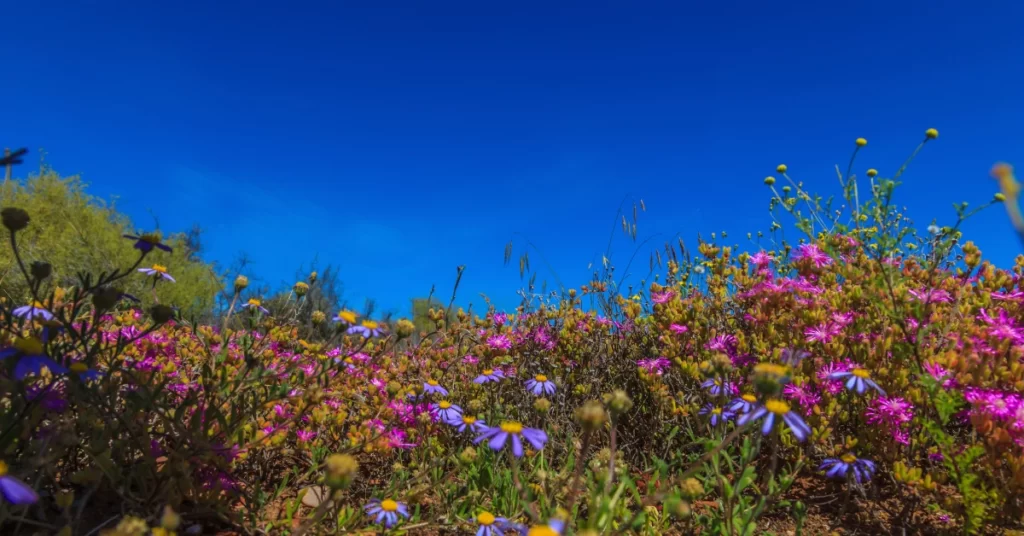
With the proper care once established, Strobilanthes will thrive season after season. These maintenance practices keep them healthy and encourage repeat flowering:
Pruning Kurinji Plants
Prune annually in late winter just before spring growth resumes. Remove dead stems, spent flowers, and weak, crossed branches. This strengthens overall plant structure and primes kurinji for the best new season growth and future flowering.
Controlling Pests
Major pests are rare indoors or outside. Occasionally monitor for spider mites, mealybugs, scales, whiteflies, and fungus gnats. Isolate and treat any infestations immediately before they spread. Neem oil applications also deter pests. Ensure good airflow and eliminate excess moisture that facilitates bugs.
Preventing Disease Problems
The main disease issue with Strobilanthes is root rot from overwatering. Well-drained soil is vital. Remove affected plants immediately to curb spread. Leaf spots may appear if humidity drops too low; increase air moisture and remove damaged foliage.
Read About How to Grow Anthurium Magnificum here
When Kurinji Bloom
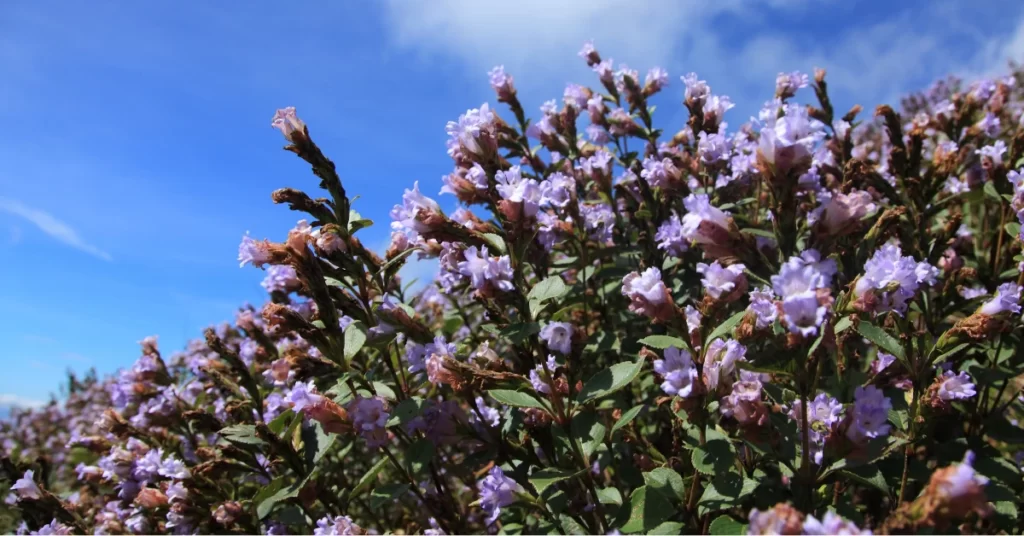
The much-anticipated flowering of Strobilanthes kunthiana is tricky to achieve and unreliable. Kurinji blooming seems triggered by a complex combination of plant maturity, temperature shifts, and other environmental cues still being researched.
In the wild, entire hillsides of plants flower simultaneously only once every 7, 11, or 12 years. The blooming cycle lasts several months before plants go dormant for over a decade, storing energy before blooming again.
Under home cultivation, kurinji individuals may flower at different times. Some specimens bloom annually or sporadically while others never show flowers for growers. Patience is required, as it may take a decade or longer before blossoms appear, if ever. But the wait makes those vivid purple-blue blooms even more magical!
Uses for Strobilanthes kunthiana
Aside from its exceptionally ornamental flowers, kurinji offers multiple benefits:
- Striking purple foliage provides unique color in gardens, patio containers, or indoor displays
- Plants are used in Indian traditional medicine to treat rheumatism, bronchitis, fevers, and menstrual issues
- Research shows potential antimicrobial properties from chemical compounds in the roots, leaves, stems, and flowers
- The flashy blooms have religious and cultural importance in India
- Honey made from the nectar has an appealing medicinal taste
So for decorative and practical uses, growing your own Strobilanthes kunthiana can yield versatile rewards.
Discover About How to Grow Pseuderanthemum Plant here
Conclusion
The mystical Strobilanthes kunthiana plant offers uncommon beauty through its gregariously flowering habits and vivid purple blooms. Called “kurinji” in India where mass coordinated blooming cycles have cultural significance, this eye-catcher carries religious meaning too.
With precise care matching its native montane ecosystem, kurinji adapts well enough to gardens that patient growers can maintain it as a jewel-toned ornamental specimen. Just be prepared to lavish specialized tending mimicking mountainside moisture, temperatures, filtered light levels, humidity and well-drained soil that this fussy flowering plant requires.
When happily established, the vibrant purple foliage alone brings drama. And if those notoriously sporadic blooms ever appear after years or decades, they will Stopyou in your tracks with their intense color displays. So try cultivating intriguing kurinji to add mystique and magic to your own landscape.
FAQs About Growing Strobilanthes kunthiana
What is special about kurinji flowering?
Kurinji or neelakurinji is unique because entire hillside populations erupt into flower simultaneously only once every 7 to 12 years. The mass blooming lasts several months, coating whole montane meadows in purple-blue color.
How often do Strobilanthes kunthiana bloom indoors or in gardens?
Flowering frequency is unpredictable in cultivation. Some kurinji plants may blossom annually or sporadically under ideal conditions. But many cultivated specimens never bloom at all, even after a decade or more of careful care. There is still much to learn about what environmental triggers influence flowering in Strobilanthes.
What colors are Kurinji flowers?
Strobilanthes kunthiana blooms always display vibrant shades of purple, violet, or blue. The intensely saturated hues contrast beautifully against the plants’ normal green foliage.
Can you grow Kurinji from seeds?
Yes, kurinji can be propagated from seed capsules collected during fall dormancy. Sow fresh seeds in flats using well-draining starting mix. Maintain warm 70°F soil temperature and even moisture during the 14-21 day germination period. Transplant seedlings when the 3-4 true leaves emerge.
Is Strobilanthes kunthiana hard to grow?
Kurinji can be moderately challenging to cultivate and coax into flowering. Success requires carefully mimicking the cooler high-altitude climate and growing conditions of its native Western Ghat mountain habitats. But with attention to its preferences, Strobilanthes thrives enough to make a captivating garden specimen.

2 thoughts on “How to Grow Kurinji | Strobilanthes kunthiana”